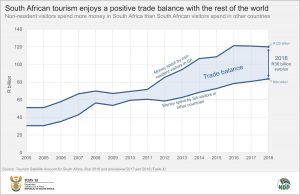SA’s tourism trade balance edges lower
South Africa enjoys a positive tourism trade balance with the rest of the world. What this means is that non-resident visitors spend more money in our country than South African travellers spend abroad. However, the trade balance surplus has narrowed since 2016.
In 2018, non-resident visitors1 (which includes both tourists and same-day visitors) spent a total of R120 billion within the borders of South Africa. This is according to data from the latest Tourism Satellite Account for South Africa (TSA) report. Much needed foreign currency is traded for rands, and visitors spend this on a range of tourism-related activities, such as accommodation, transport, food and recreation.
South Africans, on the other hand, offset this by taking money out of the country when they travel internationally. Every time you take out your credit card to pay for a meal at a London pub, or order an Uber ride in downtown Bangkok, you are transferring a small amount of money out of South Africa.
The total amount of money spent by South African visitors abroad was R84 billion in 2018.
Illustrated in the graph below, the difference between these two figures gives South Africa’s tourism trade balance with the rest of the world. The country had a positive tourism trade balance of R36 billion in 2018.
In other words, the country earns more currency from tourism-related activities than it spends in other countries. A positive tourism trade balance also has a positive impact on South Africa’s overall trade balance.
From 2011 to 2016, the tourism trade balance shifted more in South Africa’s favour. There was a surplus of R11 billion in 2011, increasing to R43 billion in 2016.
Since 2016, the tourism trade surplus has fallen. If you look at the top line in the graph, you will notice a slight drop in non-resident visitor expenditure for both 2017 and 2018. In other words, non-resident visitors have spent less in South Africa since 2016. South Africans travelling abroad, however, increased their expenditure over the same period.
The small drop-off in non-resident visitor spending mirrors the essentially flat pattern in the number of foreign visitors during 2016–2018. In 2015, 13,9 million foreign visitors arrived at the country’s ports of entry.2 This jumped by 8,4% to 15,1 million in 20163, but thereafter the number levelled out, with 14,9 million arriving in 20174 and 15,0 million arriving in 2018.5
In his address to delegates at the 2019 Africa’s Travel Indaba, President Cyril Ramaphosa referred to tourism as the new gold. This was to highlight tourism’s importance in growing economies across Africa.6 According to the TSA report, tourism contributed 2,7% to South Africa’s gross domestic product (GDP) in 2018 and provided jobs for 739 657 individuals, or 4,5% of the country’s total employed. Growing the tourism sector involves a range of initiatives, one of which is to attract foreign visitors to our shores.
For more information, download the latest Tourism Satellite Account for South Africa (TSA) report here.
1 A visitor is a traveller who takes a trip to a place outside their usual environment, for less than a year, for any purpose other than to be employed at the place visited. A visitor can either be a same-day visitor, who visits a place for less than one night, or a tourist, whose trip includes an overnight stay.
2 Stats SA, Tourism, 2015, Appendix X, page 31 (download here).
3 Stats SA, Tourism, 2016, Appendix X, page 32 (download here).
4 Stats SA, Tourism, 2017, Appendix X, page 32 (download here).
5 Stats SA, Tourism, 2018, Appendix X, page 34 (download here).
6 South African Tourism, Africa’s tourism is growing and still has untapped potential says Cyril Ramaphosa [4 May 2019] (read here).
Similar articles are available on the Stats SA website and can be accessed here.
For a monthly overview of economic indicators and infographics, catch the latest edition of the Stats Biz newsletter here.


